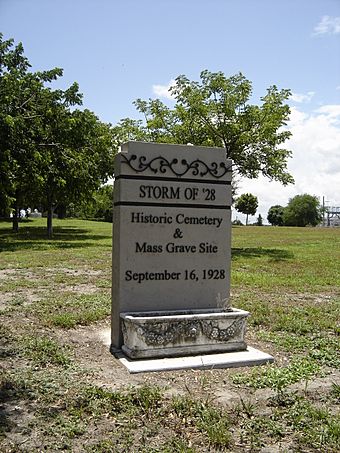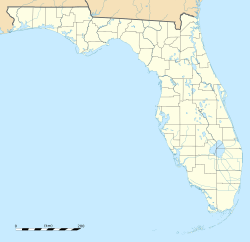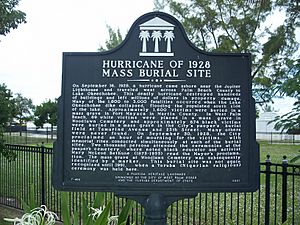Hurricane of 1928 African-American Mass Burial Site facts for kids
Quick facts for kids |
|
|
Hurricane of 1928 African-American Mass Burial Site
|
|
 |
|
| Location | West Palm Beach, Florida |
|---|---|
| NRHP reference No. | 02001012 |
| Added to NRHP | September 12, 2002 |
The Hurricane of 1928 African-American Mass Burial Site is a special cemetery and mass grave in West Palm Beach, Florida. It is also known as Pauper's Cemetery. This site is listed on the U.S. National Register of Historic Places, which means it's an important historical place in the United States.
The cemetery is located near 25th Street and Tamarind Avenue. It holds the remains of 674 African Americans and people whose race was not known. They were buried here after the terrible 1928 Okeechobee hurricane. At that time, there were unfair segregation laws. Because of these laws, most white victims of the storm received proper burials at Woodlawn Cemetery. However, many black victims were buried in mass graves like this one.
The pauper's cemetery was started in 1913. Today, it covers about 1.03 acres of land. In the 1950s, 25th Street was paved right over the northern part of the mass grave. This caused some bodies to be uncovered. After the 1928 hurricane, the people buried here were mostly forgotten. The city of West Palm Beach sold the land, and it changed owners several times. But in 1991, people started working to get the city to buy the land back. They succeeded in December 2000. On September 12, 2002, the site was added to the National Register of Historic Places.
Contents
What the Site Looks Like Now
The Hurricane of 1928 African-American Mass Burial Site is in West Palm Beach, Florida. It's at the corner of 25th Street and Tamarind Avenue. The cemetery was originally much larger, about 12 acres. But over time, parts of the land were sold. Also, 25th Street was changed to go through the cemetery.
Today, the site is about 1.03 acres. You can see several stone pillars there that say "1928." There is also a historical marker that was put up in 2003. The site has sidewalks, trees, and benches, making it a place for quiet reflection.
The bodies were buried in two layers in a special area. This area is about 40 feet by 80 feet and is surrounded by a fence. It's near 25th Street. Before the 1950s, when 25th Street was moved, the burial area went further north. A larger fence, about 40 feet by 176 feet, surrounds the inner fenced area where the mass burial took place.
History of the Site
How the Cemetery Started and the 1928 Hurricane
In 1913, the city of West Palm Beach set aside land for cemeteries. Twelve acres were put aside for different purposes. This included a city pauper's cemetery, which is where the mass burial site is now. It was located at the corner of Tamarind Avenue and 25th Street.
The 1928 Okeechobee hurricane was a very deadly storm. It caused at least 2,500 deaths, mostly among black migrant farm workers near Lake Okeechobee. Because of racial segregation at the time, white victims received coffins and proper burials. Many were buried at Woodlawn Cemetery in West Palm Beach.
However, the bodies of black people and those whose race could not be identified were handled differently. Some were burned. Many were placed in large mass graves. About 1,600 people were buried in Port Mayaca. Another 674 were buried at the pauper's cemetery in West Palm Beach. Other mass graves were in places like Miami Locks (now Lake Harbor), Ortona, and Sebring.
After the burials, the mayor of West Palm Beach, Vincent Oaksmith, declared an hour of mourning on October 1. A funeral service was held, and about 3,000 people attended. A famous educator and civil rights activist named Mary McLeod Bethune was there. A memorial was placed at Woodlawn Cemetery for the storm victims. But for a long time, there was no marker at the pauper's cemetery.
After the Hurricane: The Site is Remembered
For many years, the people buried at the site were largely forgotten. Human remains would sometimes resurface. This happened in the 1950s when 25th Street was rerouted, uncovering several bodies. The city of West Palm Beach even sold parts of the burial grounds. The land changed owners several times.
Most people didn't know about the mass burials until the 1990s. In 1991, a group called the Sankofa Society held a special blessing ceremony at the site. This brought public attention to the forgotten graves. The owner of the land at the time, Bernard Kolkana, stopped his plans to build on the property.
In 1992, city workers found human remains on the property. The bones were reburied, and their locations were marked. In 1999, a resident named Robert Hazard started a non-profit group. Its goal was to get the land back and raise money for a memorial. There were different ideas for the memorial, from a large complex with a museum to a simpler information wall and a large headstone.
In 2000, the city of West Palm Beach hired a company to use special radar. This radar could look underground to find the locations of the bodies. The survey showed that a trench, about 70 feet by 30 feet, was dug for the burials. It also confirmed that 25th Street had cut through the northern part of this mass grave. The report also found that bodies were buried in two layers.
The City Buys the Land Back
In September 2000, a city commissioner named Alfred Zucaro suggested that the city buy the land back. This would allow the city to get the land for its value, even if the owner didn't want to sell. On September 11, four out of five city commissioners voted to do this. They had tried to negotiate with the owner but couldn't agree.
However, on December 11, 2000, the city commissioners changed their minds. They negotiated with the owner and agreed to buy the land for $180,000. After this, plans for a memorial began. The site was officially named a National Registered Historic Place on September 12, 2002. In September 2003, on the 75th anniversary of the storm, the City of West Palm Beach added a historical marker to the site.
Images for kids





